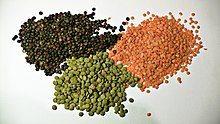Lens culinaris
| Lentil | |
|---|---|
 |
|
| Lentils | |
| Scientific classification | |
| Kingdom: | Plantae |
| (unranked): | Angiosperms |
| (unranked): | Eudicots |
| (unranked): | Rosids |
| Order: | Fabales |
| Family: | Fabaceae |
| Subfamily: | Faboideae |
| Tribe: | Vicieae |
| Genus: | Lens |
| Species: | L. culinaris |
| Binomial name | |
|
Lens culinaris Medikus |
|
| Nutritional value per 100 g (3.5 oz) | |
|---|---|
| Energy | 1,477 kJ (353 kcal) |
|
63 g
|
|
| Sugars | 2 g |
| Dietary fiber | 10.7 g |
|
1 g
|
|
|
25 g
|
|
| Vitamins | |
| Thiamine (B1) |
(76%)
0.87 mg |
| Riboflavin (B2) |
(18%)
0.211 mg |
| Niacin (B3) |
(17%)
2.605 mg |
| Pantothenic acid (B5) |
(43%)
2.14 mg |
| Vitamin B6 |
(42%)
0.54 mg |
| Folate (B9) |
(120%)
479 μg |
| Vitamin C |
(5%)
4.5 mg |
| Minerals | |
| Calcium |
(6%)
56 mg |
| Iron |
(50%)
6.5 mg |
| Magnesium |
(13%)
47 mg |
| Phosphorus |
(40%)
281 mg |
| Potassium |
(14%)
677 mg |
| Sodium |
(0%)
6 mg |
| Zinc |
(35%)
3.3 mg |
| Other constituents | |
| Water | 8.3 g |
|
|
|
|
|
| Percentages are roughly approximated using US recommendations for adults. | |
The lentil (Lens culinaris) is an edible pulse. It is a bushy annual plant of the legume family, known for its lens-shaped seeds. It is about 40 cm (16 in) tall, and the seeds grow in pods, usually with two seeds in each.
In South Asian cuisine, split lentils (often with their hulls removed) are known as lentils. Usually eaten with rice or rotis, the lentil is a dietary staple throughout regions of India, Pakistan, Bangladesh and Nepal. As a food crop, the majority of world production comes from Canada, India and Australia.
Lentils have been part of the human diet since aceramic Neolithic times, being one of the first crops domesticated in the Near East. Archeological evidence shows they were eaten 9,500 to 13,000 years ago.
Lentil colors range from yellow to red-orange to green, brown and black. Lentils also vary in size, and are sold in many forms, with or without the skins, whole or split.
According to the USDA National Nutrient Database, 100 g of raw lentils (variety unspecified) provide 353 calories; the same weight of cooked lentils provides 116 calories. Raw lentils are 8% water, 63% carbohydrates including 11% dietary fiber, 25% protein and 1% fat (table). Lentils are a rich source (20% or more of the Daily Value, DV) of numerous essential nutrients, including folate (120% DV), thiamin (76% DV), pantothenic acid (43% DV), vitamin B6 (42% DV), phosphorus (40% DV), iron (50% DV) and zinc (35%), among others (table). When lentils are cooked by boiling, protein content declines to 9% of total composition, and B vitamins and minerals decrease due to the overall water content increasing (protein itself isn't lost).
...
Wikipedia
